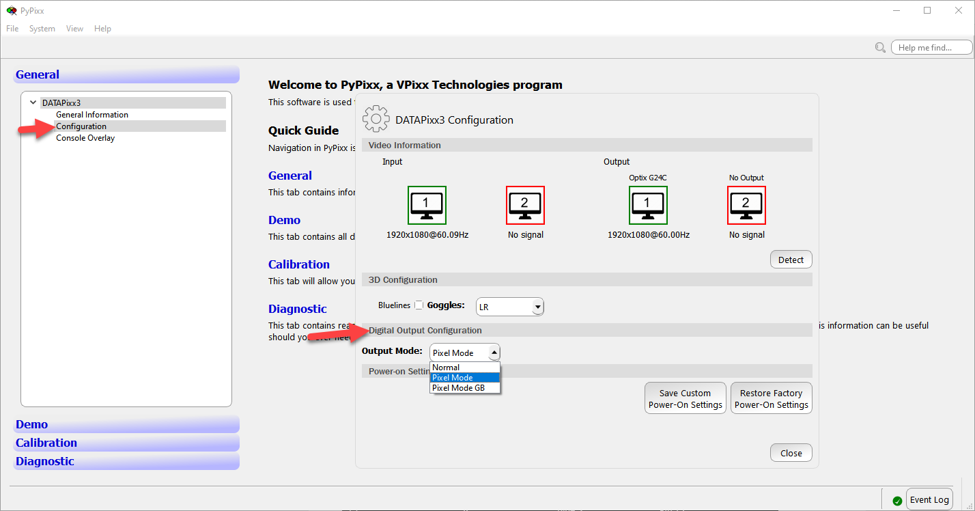Enabling Pixel Mode
Using Pixel Mode with the VIEWPixx /EEG
Pixel Mode is always enabled on the VIEWPixx /EEG. Simply connect the monitor to your computer, and the monitor’s digital output to a recording device, and triggers will be sent automatically.
Using Pixel Mode with other VPixx devices
VIEWPixx and VIEWPixx /3D
Functionality is almost identical to the VIEWPixx /EEG; however, it is important to note that the 6 ms offset between trigger and pixel stabilization only applies to VIEWPixx/EEG and VIEWPixx/3D displays with scanning backlight enabled. If the backlight is disabled, the profile of the LCD illumination changes and you will need a photodiode to calibrate the new temporal offset.
PROPixx DLP Projector
Pixel Mode can be used with the PROPixx and the Digital Output DB-25 on the PROPixx controller. The temporal relationship between the trigger and the display is different due to the display technology. The projector uses a digital micromirror display to show the entire image simultaneously, exactly one video frame after the Pixel Mode trigger is activated. At 120 Hz this offset between the trigger and illumination of all pixels on the display is precisely 8.33 ms.
DATAPixx2 and DATAPixx3 I/O hubs and a third-party display
It is also possible to use Pixel Mode with a commercial third-party display, provided the video is passed through a DATAPixx2 or DATAPixx3 system. In this case, you will have to determine the temporal characteristics of your display by comparing the timing of the digital output to photodiode measurements of your screen illumination. Commercial displays typically do not have consistent timing across different pixel colour changes, so its best to measure the onset of your specific stimuli, presented in the same manner as in your experiment. Pixel Mode is not supported on the original DATAPixx I/O hub.
Enabling Pixel Mode with PyPixx program
Pixel Mode is enabled automatically on the VIEWPixx /EEG. It can be enabled and disabled on other devices using the PyPixx program. Simply connect your computer and open PyPixx. PyPixx will automatically detect your VPixx device. In General > Configuration > Digital Output Configuration, there is a dropdown list with Pixel Mode as an item.
Whenever Pixel Mode is enabled, it will automatically send triggers based on the current video output. It will remain enabled until you revert to normal mode, or power off the device.

PyPixx Configuration Window
You will also notice that there is a “Pixel Mode GB.” This is simply Pixel Mode with only the green and blue channels activated, allowing for advanced applications. The 8 digital outputs associated with the red channel are made available for triggers coming from non-visual sources (like button presses) or when the DB-25 cable is split up into several outputs.
The method for determining the [R, G, B] values in Pixel Mode GB is the same as Pixel Mode, but the red colour channel will not impact the video-based triggering.
Enabling Pixel Mode via VPixx software tools
For the VIEWPixx, VIEWPixx /3D, PROPixx and DATAPixx devices, it is possible to enable Pixel Mode from within MATLAB or Python. Example code is shown below. For more information, please see the code documentation.
Remember that changing the device output configuration via code will not change the settings on the device until a Register Write command has been called.